Onboarding Statistics By Employee, Client, Business Effect, Challenges Faced And Future
Updated · Aug 27, 2024
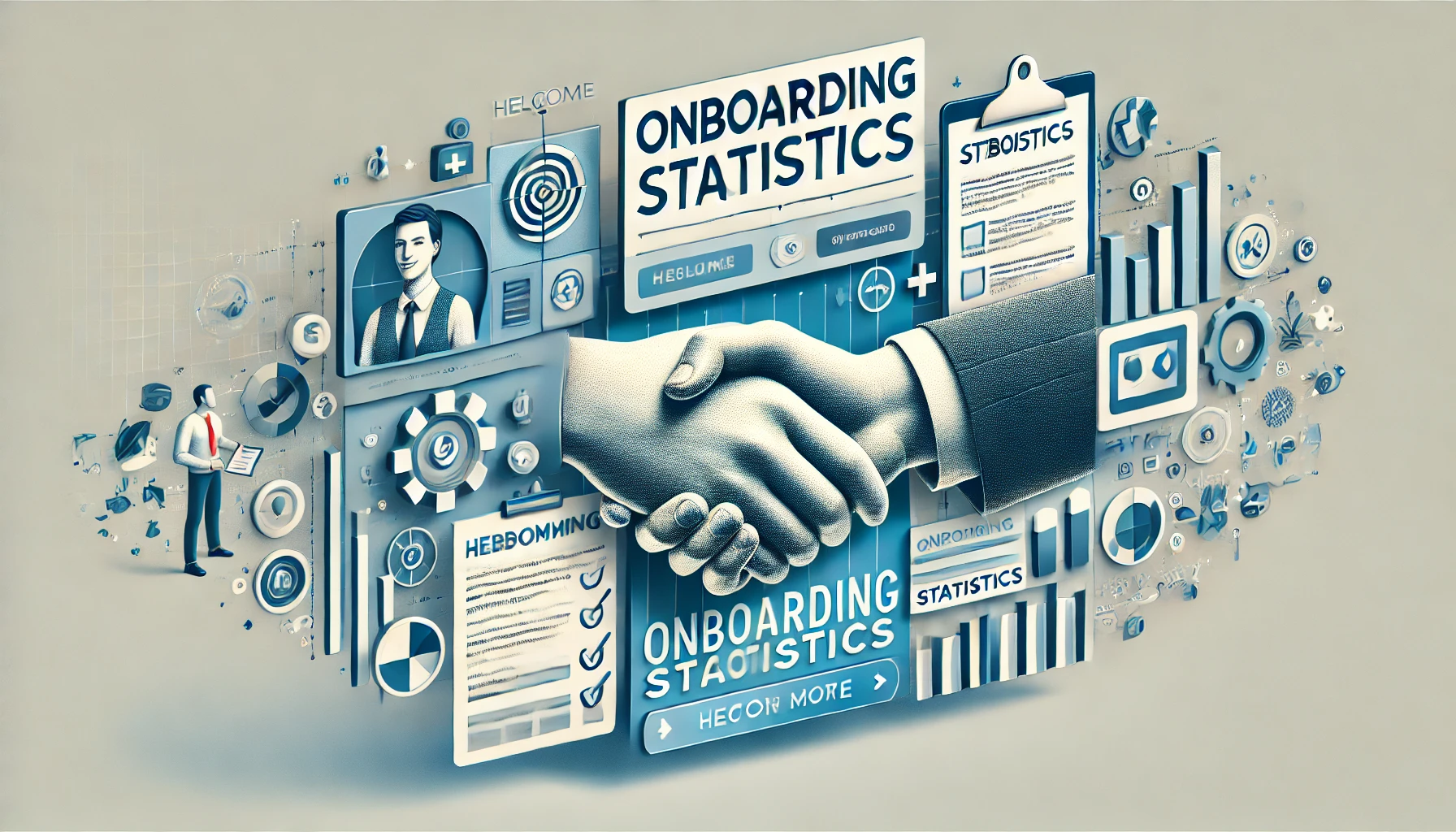
WHAT WE HAVE ON THIS PAGE
- Introduction
- Editor’s Choice
- What is Onboarding?
- How Long Does The Onboarding Process Take?
- General Onboarding Statistics
- Employee Onboarding and Retention Statistics
- Global Onboarding Statistics
- Employee Onboarding Process Statistics
- Using AI in Onboarding
- Employee Engagement and Performance Statistics
- Business Effect on Onboarding Statistics
- Effectiveness of Onboarding Process Statistics
- Challenges Faced in Onboarding
- Client Onboarding Statistics
- Onboarding Success and Poor Onboarding Statistics
- Cost of Employee Onboarding Statistics
- Future of Onboarding Statistics
- Bad Onboarding Statistics
- Remote Onboarding Statistics
- COVID-19 & Employee Onboarding Statistics
- Conclusion
Introduction
Onboarding Statistics: When you hire new employees, the first few weeks are crucial. This time is both exciting and stressful, and anyone who has started a new job knows how important a well-planned onboarding process is. Onboarding is key to keeping new employees engaged. Remember, top talent is always in high demand. Follow the right steps during onboarding to ensure new employees stay on time.
We found some surprising facts about employee onboarding that show why it’s worth investing in. Here are some important Onboarding Statistics you should know.
Editor’s Choice
- 77% of new employees say that onboarding is “critical” in deciding whether they stay with a company long-term.
- Companies with a structured onboarding program see an 82% improvement in new hire retention, as stated by Onboarding Statistics.
- 53% of HR professionals say that a better onboarding process boosts employee engagement.
- 69% of employees are more likely to stay with a company for three years if they have a great onboarding experience.
- Onboarding Statistics stated that effective onboarding can boost employee performance by 11.5%.
- Organizations with a standard onboarding process have 50% higher new hire productivity.
- 20% of employee turnover happens within the first 45 days of employment.
- 40% of employees who have poor onboarding will leave their jobs within the first year.
- New hires who go through a structured onboarding program are 58% more likely to stay with the company after three years.
- Companies with a standard onboarding process also see 50% better new hire retention.
- 91% of employees believe they would stay with a company for the next three years if they had a great onboarding experience.
- Only 12% of employees think their company does a great job with onboarding.
- 40% of employees find a disorganized onboarding process to be a major drawback.
- Employees who have a structured onboarding program are 69% more likely to stay at a company for three years.
- According to onboarding statistics, nearly 30% of employees leave a job within the first 90 days of starting.
- Organizations with a strong onboarding process see a 50% improvement in new hire retention.
What is Onboarding?
Onboarding is a human resources term for getting a new employee settled into a company. Also called organizational socialization, it’s a key part of helping employees understand their new role and what’s expected of them. Onboarding helps them fit in smoothly with the rest of the team.
The onboarding process includes many activities, from making the job offer to training with the team.
How Long Does The Onboarding Process Take?
Onboarding can range from a few weeks to a year, but the best programs typically last at least a few months. The goal is for employees to feel confident and capable by the end of the onboarding process. There’s no strict rule on how long onboarding should be, but it’s crucial to be thorough. Many companies only offer onboarding for a month or a few weeks, which can leave new hires feeling overwhelmed and disconnected.
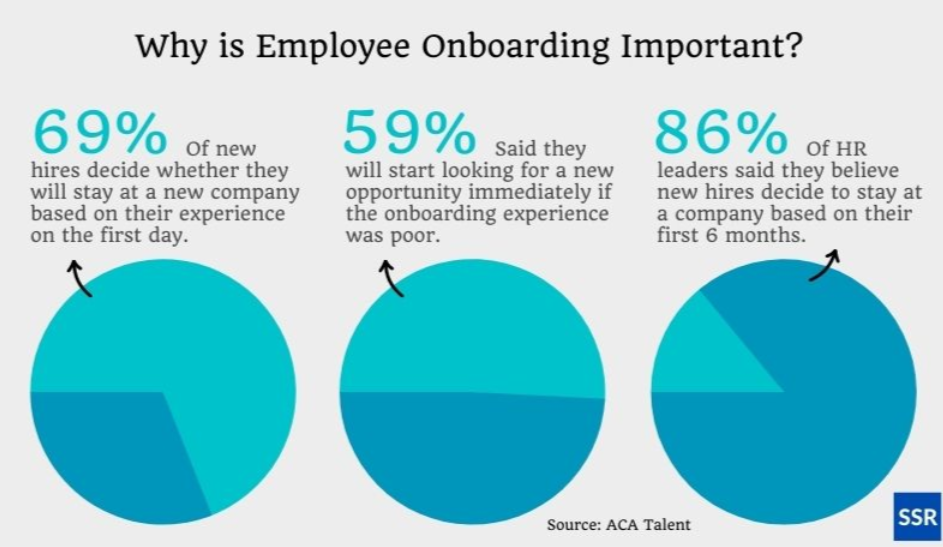
(Source: selectsoftwarereviews.com)
HR experts generally recommend a 90-day onboarding period, though some suggest extending it up to a year. This longer duration helps employees get familiar with the company, fully absorb their training, and feel comfortable in their roles.
Onboarding includes several different processes, but there’s no official definition of what should be included, and opinions vary on what counts as onboarding.
Here are some common onboarding activities:
- Job offers
- Salary discussions
- Completing new hire paperwork
- Learning company policies and culture
- Training for the job
- Reviewing the employee handbook
- Filling out benefits forms
- Learning about employee benefits
- Touring the facilities
- Meeting with executives
- Meeting with team members
General Onboarding Statistics
- One in three new hires leaves a job within the first 90 days, making a strong onboarding process crucial.
- 70% of new hires decide if a job is right for them within the first month, and 29% decide within the first week. On average, companies have 44 days to make a great impression and keep new hires longer.
- Nearly 50% of companies only provide onboarding for two weeks. Aptitude Research suggests extending onboarding beyond the first 30 days.
- Despite this, only 43% of employees get more than a one-day orientation and a benefits packet.
- Onboarding Statistics stated that only 39% of employees find their onboarding clear, while 32% need clarification and 22% find it disorganized. This can hurt early engagement.
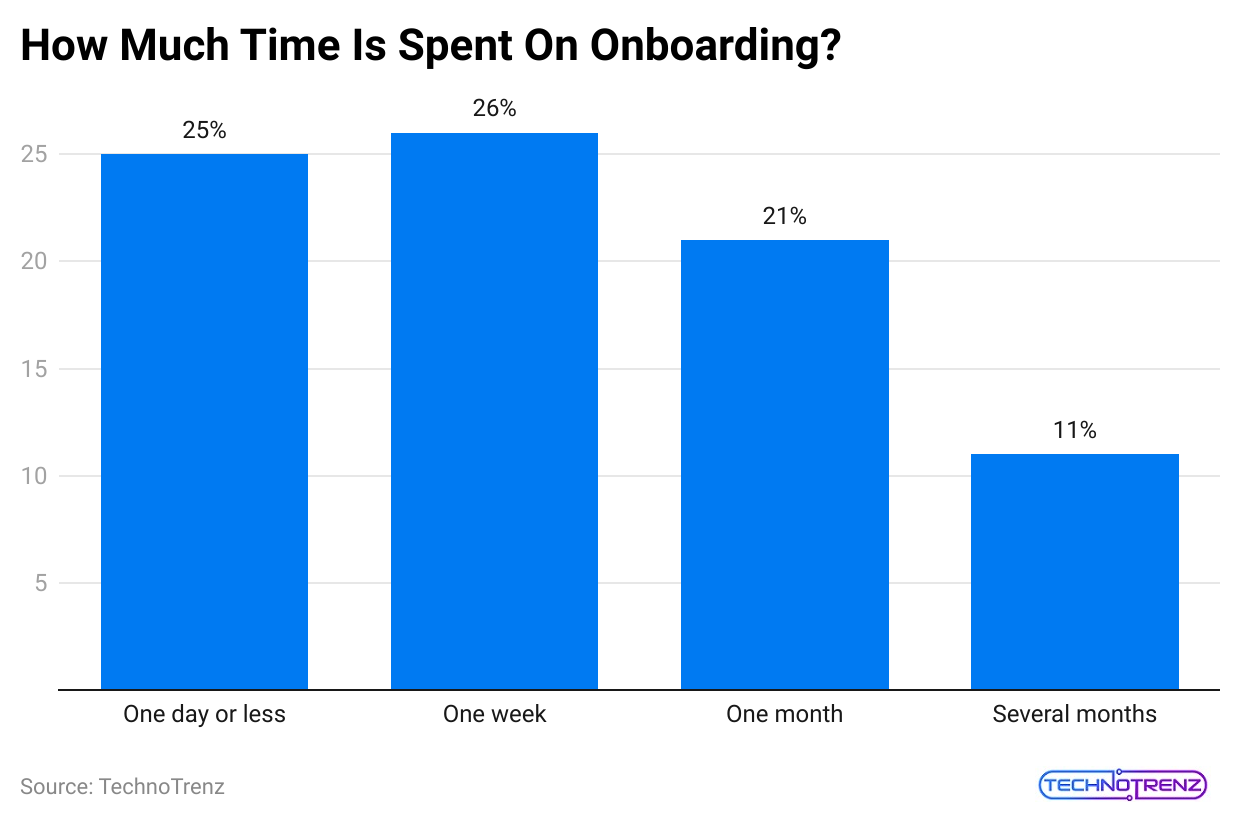
(Reference: zippia.com)
- 17% of HR teams say a poor first impression affects their employer’s brand. Many HR teams feel overwhelmed by paperwork, and 29% say manual onboarding processes frustrate new hires.
- As surveyed by the Bureau of Labor Statistics in 2024, 68.1 million people in the US left their jobs in 2023.
- Onboarding Statistics stated that almost 76% of IT leaders think that employee offboarding poses a big security risk.
- Poor offboarding can hurt your company’s reputation. Only 45% of people who left a job are happy with how their exit was handled, and just 24% are extremely satisfied.
- Employees who have a positive exit experience are 2.9 times more likely to recommend the company to others.
- 28% of “new” hires are returning employees who came back after working elsewhere for less than three years.
- In 2023, only 23% of employees felt they were thriving at work, 59% were quietly quitting, and 18% were actively disengaged.
- Disengaged employees cost the world $8.8 trillion in lost productivity. Companies need to focus on engagement from Day 1. (Gallup, 2023)
- 35% of HR leaders believe that focusing on onboarding to make new hires feel engaged and productive quickly is the best way to improve overall employee engagement.
- Unfortunately, 35% of HR professionals struggle to create an onboarding experience that helps employees feel engaged and settle into their new roles quickly.
Employee Onboarding and Retention Statistics
- One in three new employees quits within the first 90 days, so having a strong onboarding process is crucial.
- 70% of new hires decide if the job is a good fit within the first month, and 29% make that decision within the first week. On average, companies have 44 days to create a great experience to keep new hires longer.

(Reference: testgorilla.com)
- About 50% of companies only provide onboarding for two weeks. Aptitude Research suggests extending this period beyond 30 days.
- Despite this, only 43% of employees get more than a one-day orientation and a benefits packet.
- Only 39% of employees find their onboarding clear. 32% need clarification and 22% find it disorganized. This can affect how engaged they feel.
- 17% of HR teams say that a poor first impression affects their company’s reputation. Many HR teams are overwhelmed with paperwork, and 29% say that manual onboarding frustrates new hires.
- In 2023, 68.1 million people in the US left their jobs.
- Onboarding Statistics stated that nearly 76% of IT leaders think that offboarding employees poses a big security risk.
- Poor offboarding can damage your company’s reputation. Only 45% of employees are happy with how their departure was handled, and just 24% are extremely satisfied.
- Employees who leave on good terms are 2.9 times more likely to recommend the company to others.
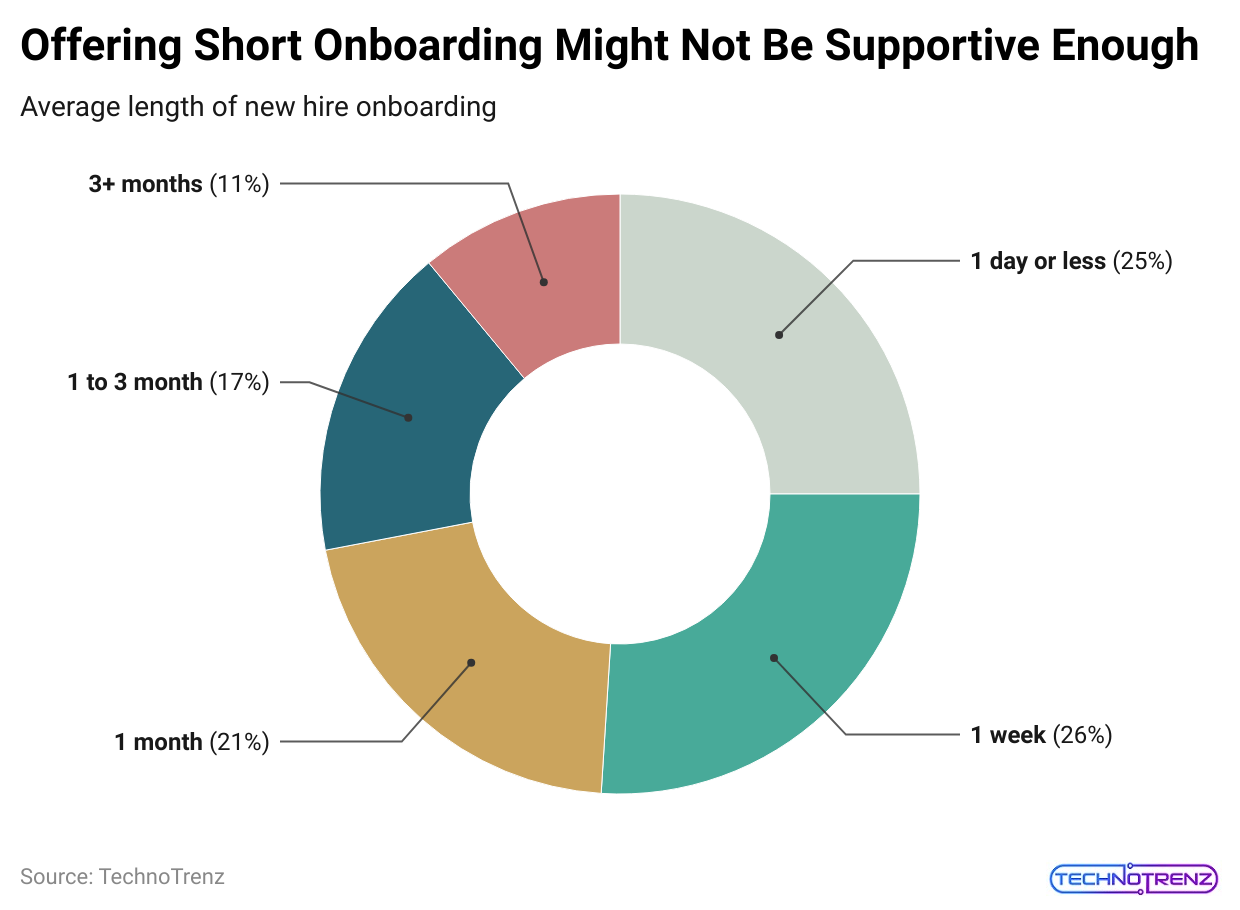
(Reference: testgorilla.com)
- 28% of new hires are returning employees who came back after working elsewhere for less than three years.
- In 2023, only 23% of employees felt they were thriving at work, 59% were quietly quitting, and 18% were actively disengaged.
- Disengaged employees cost the world $8.8 trillion in lost productivity. Companies need to focus on engagement right from Day 1.
- 35% of HR leaders believe that focusing on onboarding to help new hires feel engaged and productive quickly is the best way to boost overall employee engagement.
- Unfortunately, 35% of HR professionals find it hard to create an onboarding experience that helps employees feel engaged and settle into their new roles quickly.
Global Onboarding Statistics
- Onboarding Statistics stated that almost $37 Billion was Spent on Unproductive Employees in the UK and US.
- Onboarding is a weak spot for many companies. They focus on orientation, paperwork, and administrative tasks rather than strategies for long-term employee retention.
- This can lead to new hires being disengaged early on, which results in lower productivity later.
- In the UK, employee engagement is just 45%. Effective onboarding could help improve this.
- For comparison, employee engagement is 54% in France, 56% in Australia, and 60% in the US.
- Only Singapore and Hong Kong have lower engagement levels than the UK, as per Onboarding Statistics.
- Consequently, one in five UK workers leaves their job within the first two years.
- In Canada, 57% of employees feel loyal to their current jobs, compared to 70% in other countries.
- Additionally, one in five Canadians is actively seeking a new job, while 43% are open to new opportunities, even if they’re not actively looking.
- Many employers in Western Canada are working to enhance their onboarding processes to reduce turnover and avoid the high costs associated with replacing employees.
- Of the 460 HR managers in Australia, 33% believe their onboarding process is excellent. Another 51% think it’s good, while 16% say it’s only adequate.
- Onboarding Statistics stated that many employees in Australia quit their jobs during the onboarding process because of poor experiences.
- New hires often have to navigate unfamiliar environments or deal with excessive paperwork, which leads to 43% of Australian employers losing employees within the first month.
Employee Onboarding Process Statistics
- Managing the employee onboarding process is crucial for both new hires and companies.
- A well-planned onboarding process not only handles administrative tasks efficiently but also creates a positive and engaging start for new employees.
- Onboarding Statistics stated that almost 55% of companies need to track how well their onboarding programs work.
- Even though 60% of HR leaders understand the importance of onboarding for integrating employees into the company culture, only 30% of onboarding programs focus on culture.
- Cultural engagement is crucial, as 58% of companies consider it the most significant factor in onboarding. Plus, 90% of employees decide whether to stay with a company within their first year, highlighting the importance of early engagement.
- 72% of employees say that having 1:1 time with their direct manager is key to a good onboarding experience.
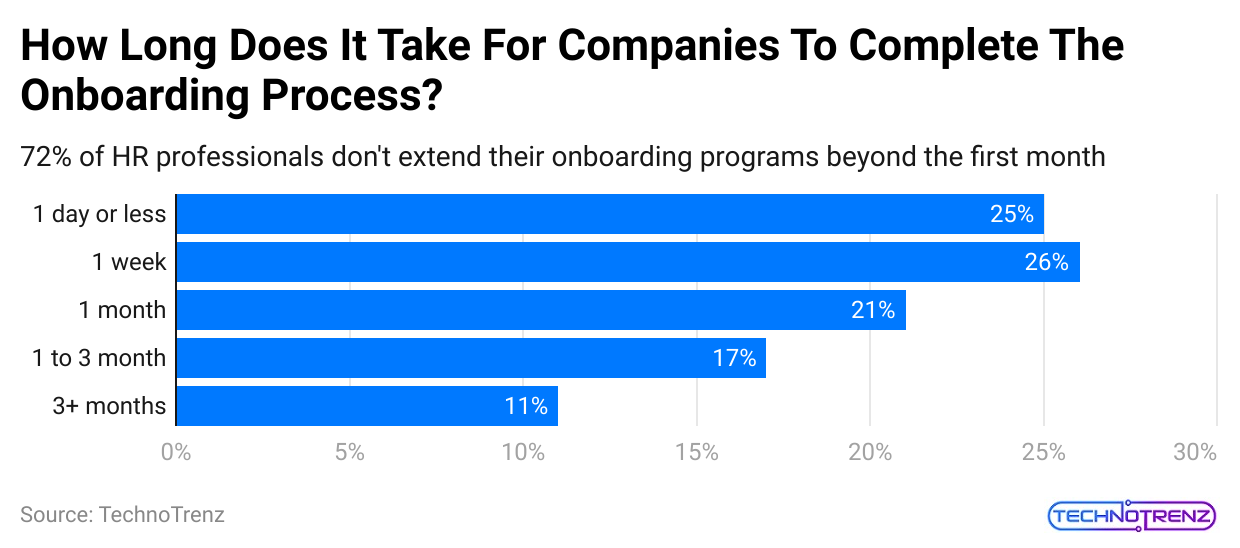
(Reference: withe.co)
- 53% of HR professionals believe that a better onboarding process leads to higher employee engagement.
- Employee preferences show that 86% of new hires want some time to adjust, stressing the importance of a well-paced onboarding process.
- 72% of HR professionals do not extend their onboarding programs beyond the first month.
- The suggested onboarding period is 90 days, as effective onboarding should last at least three months, as stated by Onboarding Statistics.
- New hires typically take 8 to 12 months to reach the same level of proficiency as their more experienced colleagues. However, only 28% of businesses offer onboarding programs lasting at least a month.
Using AI in Onboarding
- As the business world changes, more companies are using AI. Recent data shows that 35% of companies globally have already adopted AI, and another 42% are exploring its potential.
- In the USA, 68% of organizations use AI for hiring and onboarding, according to Onboarding Statistics.
- Interestingly, half of the companies in this study believe that improving the onboarding experience is a key reason to consider AI and automation.
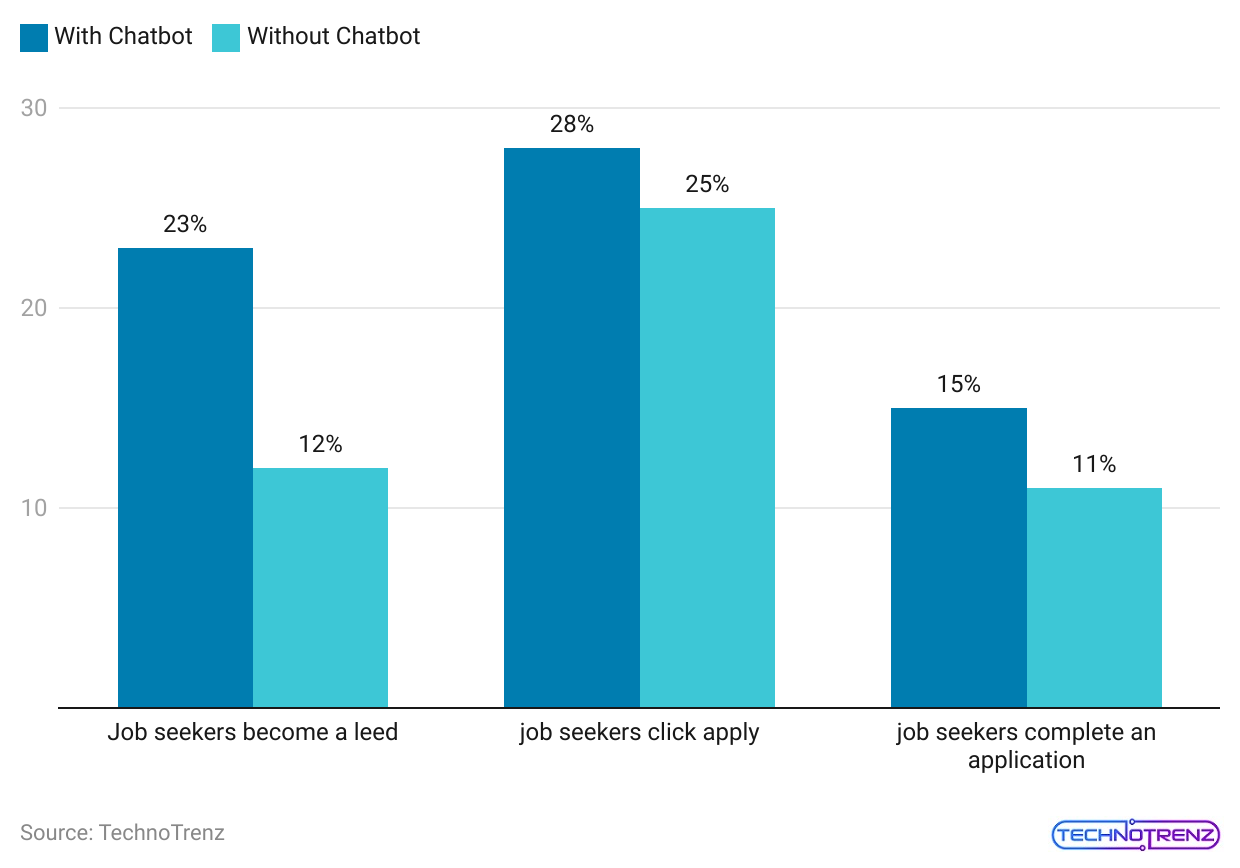
(Reference: optnation.com)
- The onboarding process that covers interviews, job offers, negotiations, and acceptance—can reveal a lot about the company you’re joining.
- Often, onboarding is a crucial aspect that needs to be noticed, which can impact whether new employees stay engaged or become disengaged.
- This is especially true for millennials, who are new to the workforce and may need to learn what to expect, as stated by Onboarding Statistics.
- Onboarding Statistics found that 33% of new hires leave their jobs within six months due to poor onboarding.
- However, the same study also showed that a great onboarding experience leads to 69% of employees staying longer and being more productive.
- Additionally, 41% of respondents expect to start using automated onboarding within the next 6 to 12 months.
- This shows how quickly companies are realizing AI’s benefits for making onboarding more efficient, personalized, and user-friendly.
- With AI changing how businesses operate, companies are embracing this technology to improve their processes, from better onboarding experiences to automating repetitive tasks.
Employee Engagement and Performance Statistics
- Only 23% of workers feel engaged at their jobs, as per Onboarding Statistics.
- An “ideal” onboarding program can boost job performance by 114% and increase engagement by 135%.
- 89% of employees who had a good onboarding experience feel engaged at work.
- Companies with strong onboarding processes see a 70% increase in new hire productivity.
- Nearly 20% of employees quit within their first week, and 17% leave within the first month.
- 51% of employees who leave their jobs do so within the first six months.
- Of those who quit, 23% wanted clearer explanations about their roles, and 21% expected better training.
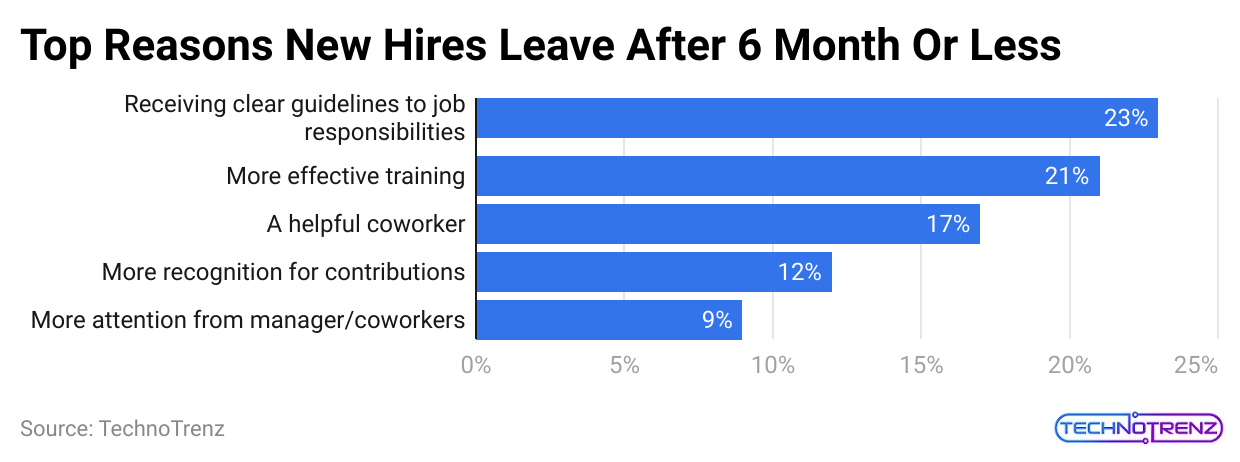
(Reference: zippia.com)
- 17% of departing employees think a friendlier workplace could have made them stay.
- Another study found that 66% of employees leave due to issues with engagement, company culture, well-being, and work-life balance.
- Companies with weak diversity, equity, and inclusion (DEI) programs are 32% more likely to see higher quitting rates.
- In a survey of new hires, only 59% said they would choose the job again.
- 36% of employees feel engaged at work, while 95% of HR leaders believe that employees are at least somewhat engaged.
- 40% of new employees feel that the company’s branding needs to match their experience after joining.
- Only 28% of workers would recommend their employer.
- 63% of employees who feel unhappy at work are looking for new jobs, compared to only 50% of all employees.
- Employees who feel fulfilled at work are 297% more likely to recommend their workplace to others.
- Fulfilled employees stay in their jobs three years longer than those who are unfulfilled.
- Employees who feel a strong sense of belonging at work are 252% more likely to stay in their jobs for a year.
- This sense of connection boosts the likelihood of doing great work by 236%, as per Onboarding Statistics.
- When employees feel a strong sense of purpose at work, their desire to stay for a year increases by 254%.
- A strong sense of purpose also raises the chances of doing excellent work by 373%.
Business Effect on Onboarding Statistics
Financial Aspects:
- The global onboarding market was expected to reach $793 million by 2022.
- On average, it costs around $4,000, and takes 24 days for employers to hire a new employee.
- In 2018, US employers lost $617 billion due to employee turnover.
- In 2019, the top 10 onboarding vendors held 58.7% of the global market share.
- For the same year, companies spent about $3,000 to onboard each new hire.
- Companies often conduct poor exit interviews 80% of the time.
- New hires tend to be less productive initially, which can lead to revenue losses of 1% to 2.5%.
- With a strong onboarding program, new hire performance can improve by 11%.
- In 2020, voluntary turnover cost organizations over $630 billion, as stated by Onboarding Statistics.
- Over the next 3-5 years, 51% of employers believe using health and wellness benefits will be even more important for keeping employees loyal and retaining talent.
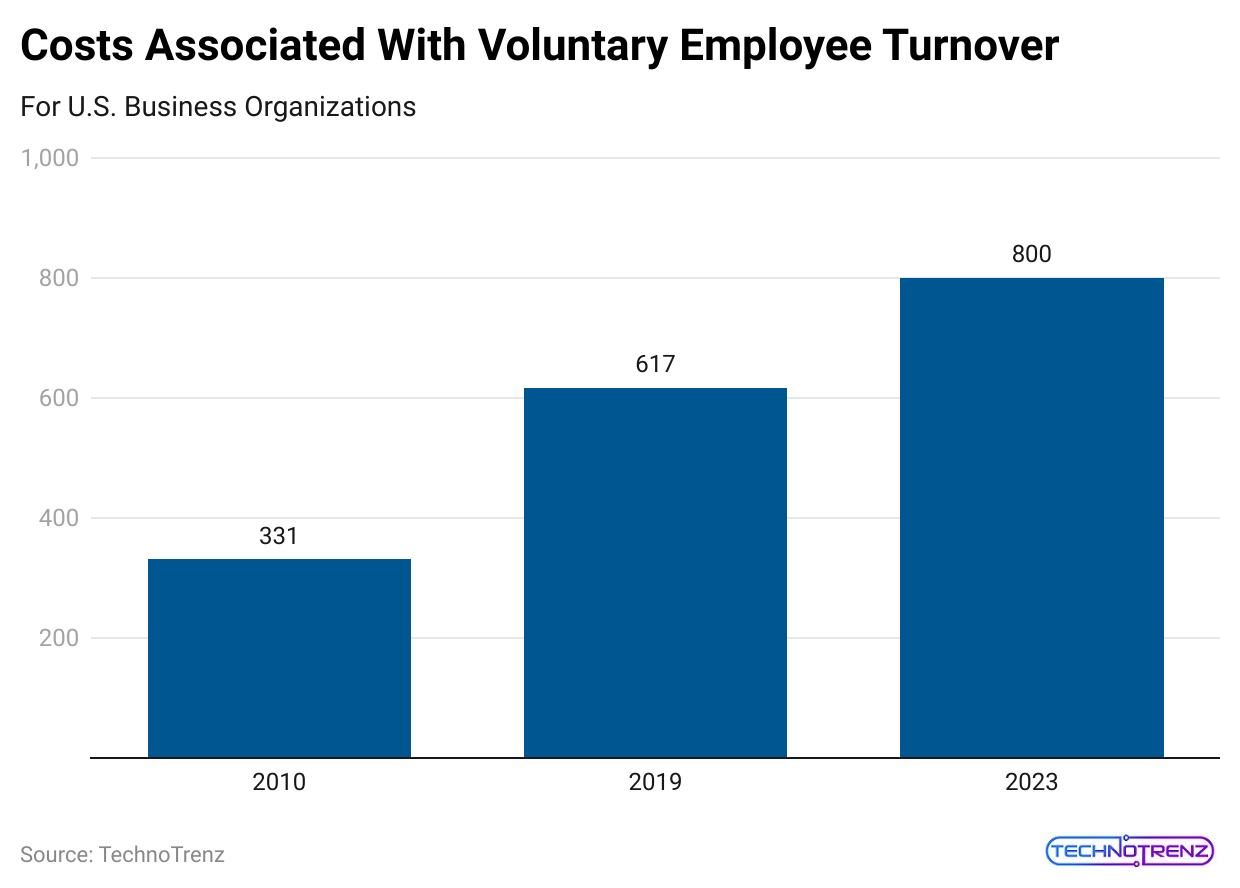 (Reference: financesonline.com)
(Reference: financesonline.com)
Non-Monetary Factors:
- A 2017 study found that 87% of employees expect their companies to support their work-life balance needs.
- Manager satisfaction improves by 20% when employees receive formal onboarding training.
- 61% of businesses say their wellness programs have led to healthier lifestyle choices among employees.
- 84% of companies now offer financial security programs, such as budgeting resources, debt management tools, or student loan counseling, as part of their well-being strategies.
- Employee well-being is a key focus for 78% of employers, as stated by Onboarding Statistics.
- Companies that automate onboarding tasks see 16% better retention rates for new hires.
- Automating onboarding tasks also leads to an 18% improvement in new hire performance.
Effectiveness of Onboarding Process Statistics
- 77% of new hires say that onboarding is “critical” for deciding if they will stay with a company long-term.
- Good onboarding can boost employee performance by 11.5%.
- Companies with a standard onboarding process see 50% more productivity from new hires.
- New employees who go through a structured onboarding program are 58% more likely to stay with the company after three years.
- 40% of employees think a disorganized onboarding process is a big turnoff.
- Employees who had structured onboarding were 69% more likely to remain at a company for three years.
- A strong onboarding process can improve new hire retention by 50%, as stated by Onboarding Statistics.
- Onboarding programs can increase employee productivity by 60% to 70%.
- Companies with well-organized onboarding can boost employee engagement by up to 50%.
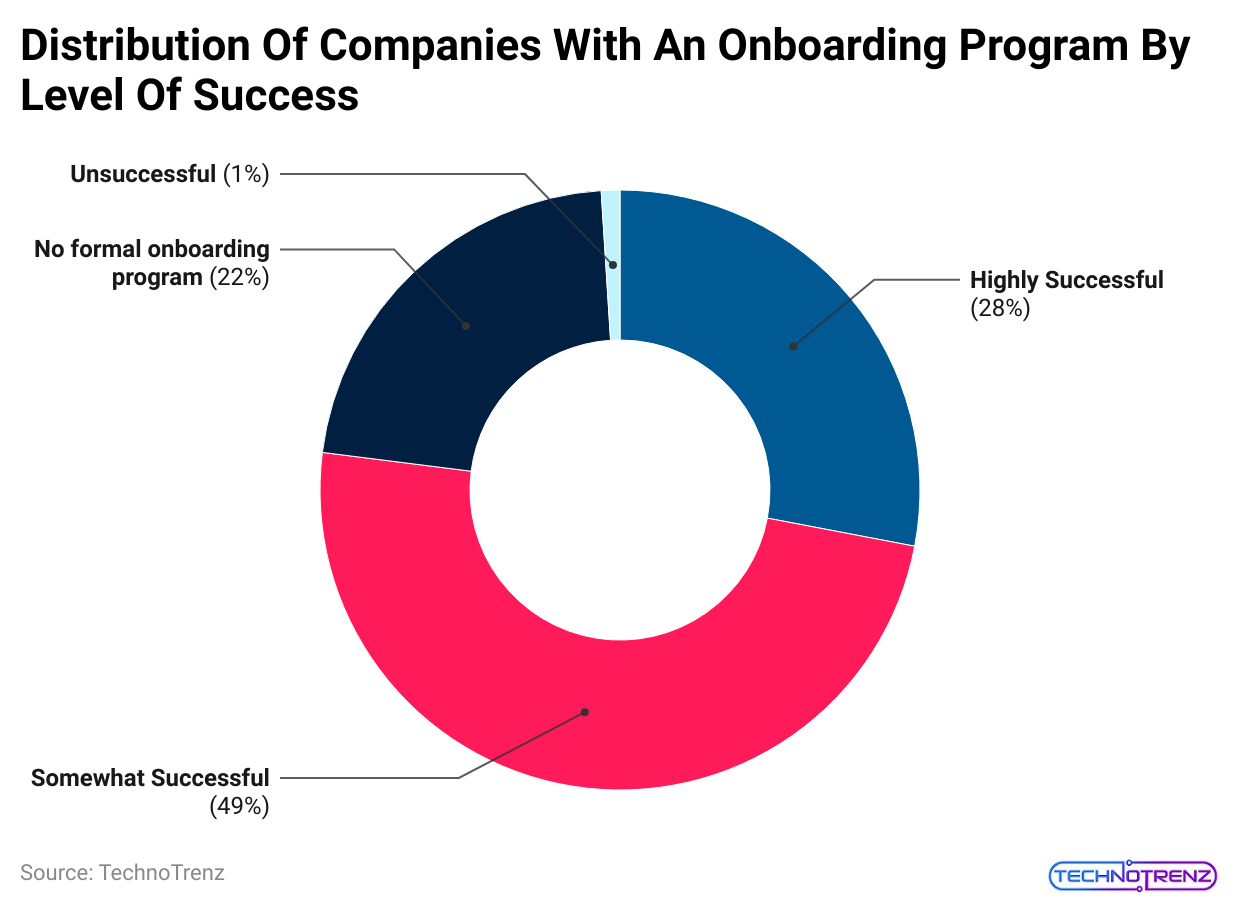 (Reference: 99firms.com)
(Reference: 99firms.com)
- Among companies with phased onboarding, 54% see faster time-to-productivity.
- Only 12% of employees feel their company does a great job with onboarding.
- 40% of employees think a chaotic onboarding process is a major drawback.
- 37% of companies extend their onboarding beyond the first month.
- 91% of employees believe their company’s onboarding process could be improved.
- Companies with a structured onboarding process report 54% higher new hire productivity.
- 29% of employees are more likely to experience burnout if their onboarding is poor.
- Onboarding Statistics stated that around 44% of companies have a formal onboarding program.
- 66% of companies with strong onboarding programs see employees reach productivity quickly.
Challenges Faced in Onboarding
- Disconnect Between Hiring and Onboarding – About 40% of HR professionals report that there’s often a gap between the hiring process and the actual onboarding.
- Employee Engagement Issues – 36% of HR specialists say keeping new employees engaged is a challenge.
- Remote Onboarding Difficulties—According to Workable, 37.4% of respondents need help onboarding employees who work remotely.
- Program Length, Personalization, and Automation – Problems with the length of onboarding programs, personalizing the experience, and automating processes are key areas that need improvement.
- Job Duties and Expectations—66% of people find it difficult to understand their job duties and meet expectations during onboarding.
- Technology Problems and Lack of Clarity – Technology issues affect 56% of employees, and 64% face challenges due to unclear information. Only 40% of employees find that their job matches what was described during the interview.
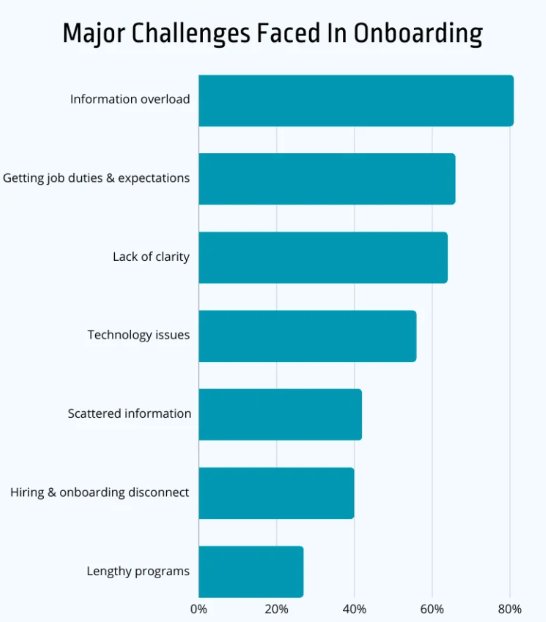 (Source: jobera.com)
(Source: jobera.com)
Additionally, information overload is as significant a problem as having too little information:
- Overwhelming information – 81% of new hires say they feel overwhelmed by the amount of information they receive during onboarding.
- Scattered Information and Lack of Clarity – 42% of employees agree that the information they receive is disorganized and unclear.
Client Onboarding Statistics
- Over 90% of customers think the companies they deal with could improve how they attract new clients.
- A user-friendly website can bring in 74% more clients, while a difficult-to-use site can drive away 50% of them.
- 43% of small and medium-sized business (SME) employees say their company has lost clients due to poor processes.
- According to onboarding statistics, 64% of consumers expect businesses to contact them in real time, compared to 80% of B2B clients.
- 87% of businesses agree that their clients are no longer happy with traditional customer service methods.
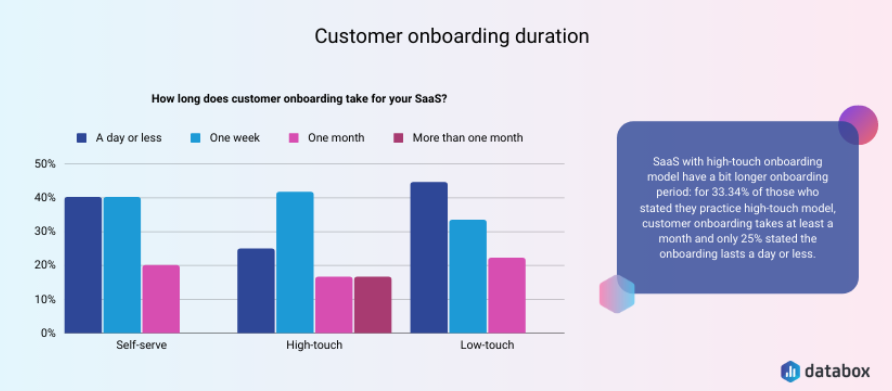
(Source: databox.com)
- 74% of companies have specialized teams to handle onboarding new customers.
- 76% of organizations require email confirmation before giving access to their dashboard, and 66% use a single sign-on system throughout the registration.
- 64% of consumers want real-time communication from businesses, while 80% of B2B clients expect it.
- Onboarding Statistics stated that over 90% of clients believe businesses could do better at onboarding new customers.
- 74% of SaaS companies found that more than simplifying onboarding and registration was needed to help customers understand the product’s value.
- Research by Gartner shows that 20% of a company’s current clients could generate 80% of its future revenue.
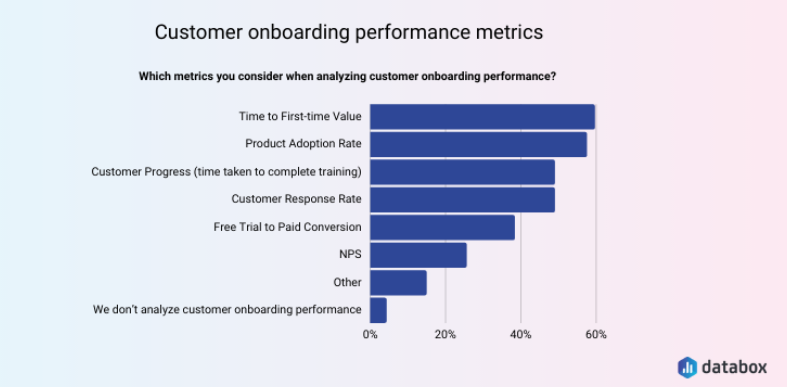
(Source: databox.com)
- Onboarding templates can boost effectiveness by 20%, cut installation time by 49%, and reduce meeting time with clients by up to 86%.
- 98% of digital bank customers had their accounts set up within a week, as stated in Onboarding Statistics.
- Clients who thought a company’s onboarding was effective were willing to pay 12% to 21% more than average.
- In the first 21 days after becoming clients, those with a positive onboarding experience had a much lower drop-off rate of about 1.6%.
Onboarding Success and Poor Onboarding Statistics
- Onboarding can greatly affect productivity, retention, and engagement. Here are some key statistics about successful onboarding:
- Managers are 20% more satisfied when their employees receive standard onboarding training. This training helps employees perform well, whether they’re supervised or not.
- Employees who undergo longer onboarding programs (up to a year) become fully proficient 34 times faster than those with shorter onboarding. Longer onboarding allows new hires to better understand their roles and adapt to the company culture.
- A great onboarding experience helps 69% of employees stay with a company for at least three years.
- Proper onboarding increases loyalty and reduces the likelihood of employees leaving soon after they start.
- A strong onboarding process can boost the chances of an employee staying with the company by about 82%.
- Good onboarding helps reduce early job dissatisfaction and makes employees feel more settled.
- 60% of companies still need to set goals or milestones for new hires. Setting clear, achievable goals is a key part of effective onboarding, helping new employees understand their tasks and progress.
- 35% of companies spend nothing on onboarding new employees. While companies invest heavily in hiring, they often neglect to spend on onboarding, which can improve retention and productivity.
- Only 12% of organizations provide a great onboarding experience. Despite investing in recruiting, many companies still need to ensure a solid onboarding process.
- Onboarding Statistics stated that almost 32% of global executives report that their onboarding processes need to be improved, leading to poor experiences for new hires.
- Only 37% of companies have onboarding programs that last more than a month. Short onboarding periods, such as one week, often leave new employees confused and less committed. Programs should last from three months to a year.
- Most companies only provide onboarding for seven days. While onboarding software often recommends three months to a year, many companies cut it short, which can lead to poor integration and lower productivity.
Cost of Employee Onboarding Statistics
- Onboarding Statistics stated that it costs about $4,000 on average to onboard a new employee.
- Replacing an employee due to turnover costs between $3,000 and $18,000.
- Replacing an employee typically costs 16% to 20% of their annual salary.
- Only 3% of businesses expect more than one-third of their employees to resign within the next year.
- US employers lost $617 billion in 2018 because of employee turnover.
- In 2019, the top ten onboarding vendors controlled 58.7% of the global market.
- New hires are often less productive, which can cause companies to lose between 1% and 2.5% of their revenue.
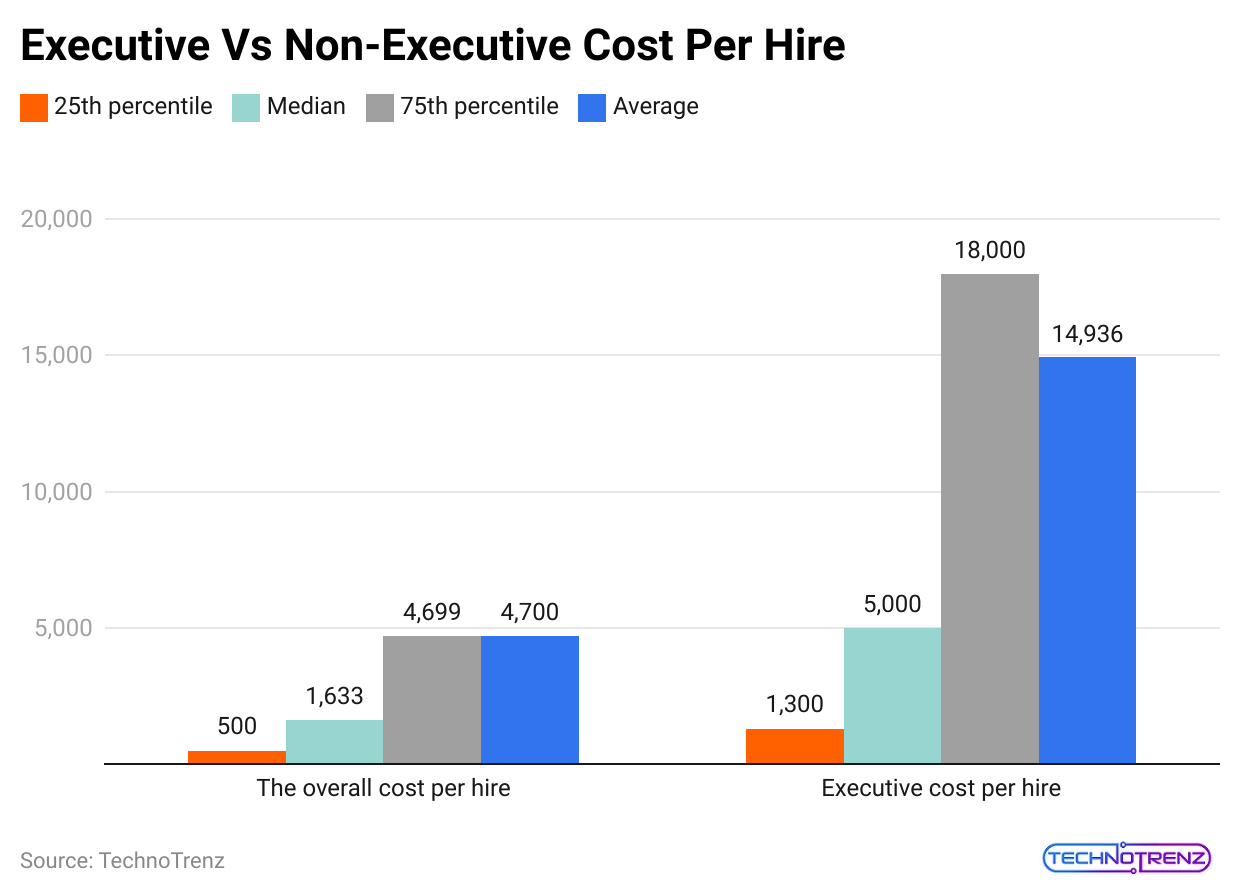
(Reference: linkedin.com)
| The overall cost per hire | Executive cost per hire | |
| 25th percentile | $500 |
$1,300 |
|
Median |
$1,633 | $5,000 |
| 75th percentile | $4,699 |
$18,000 |
|
Average |
$4,700 |
$14,936 |
- An effective onboarding program can boost employee performance by 11%.
- Voluntary turnover is expected to cost organizations more than $630 billion by 2020.
- By 2022, the global onboarding market is projected to be worth $793 million.
- 53% of HR professionals say that a better onboarding process boosts employee engagement.
- The main goal of onboarding programs is to help new employees fit into the company’s culture (62%). The next goal is to complete compliance requirements (57%).
- 87% of businesses find that assigning a mentor during onboarding is very effective.
- Employees who have a positive and well-organized onboarding experience are 18 times more likely to be strongly committed to their employer.
- 88% of employees think their companies could make improvements to their onboarding programs.
Future of Onboarding Statistics
Automating Onboarding:
- Automating onboarding tasks can boost employee retention by 16%, as per HiringThing, 2024.
- Manual paperwork and complex processes can be discouraging for new hires.
- Automating these tasks saves time and lets you and your new employees focus on what matters.
- Folks HR’s platform allows you to create efficient onboarding programs, assign and schedule tasks, and send automatic reminders to prevent delays. It also simplifies document management with e-signatures.
AI in Onboarding:
- 50% of HR professionals believe that AI can enhance onboarding processes, as per LeenaAI, 2024.
- AI tools are expected to play a big role in transforming onboarding by automating tasks, improving processes, and tailoring the experience to each employee’s needs and preferences.
Future of Onboarding:
- 77% of HR professionals think onboarding will become more important in the future, as per Talmundo, 2024.
- It’s crucial to invest in improving your onboarding processes now to stay effective later.
- Using HR tools and providing strong human support and thorough training are key to creating a positive onboarding experience for new employees.
Bad Onboarding Statistics
- A recent study showed that only 12% of employees feel their company’s onboarding process is good, even though it’s very important.
- Another survey found that just 1 in 10 employees think their company has effective onboarding practices.
- Despite spending about $11,000 on hiring and turnover, many companies need to invest in onboarding.
- Proper onboarding is just as crucial as hiring new talent, especially for improving employee productivity.
- Over half of companies use outdated onboarding methods that involve a lot of paperwork.
- As a result, only some employees are satisfied with their onboarding experience.
- Many employees view their onboarding programs as inconsistent, reactive, and informal. Good onboarding programs are more people-focused and have clear goals.
- While the average onboarding period is between 90 days and a year, most companies only provide a week of onboarding.
- This short time can leave new hires feeling unmotivated and struggling to adjust to the company culture and their new roles.
- Studies show that new employees are more likely to leave if their onboarding experience is better, as stated by Onboarding Statistics.
- Employers spend about $4,000 and 24 days to hire someone, and this cost can double if the onboarding experience is negative.
- Poor onboarding also affects productivity and team morale.
- Onboarding Statistics show that nearly a quarter of new hires would start looking for a new job if they needed a better onboarding experience.
- Additionally, 41% might look for another job, 51% would work harder if they had a positive experience, and about 33% might put in extra effort.
- Replacing an employee is costly, not just because of the direct expenses but also due to lost productivity.
- The cost of onboarding a new employee adds to the overall expense and impacts productivity.
- Many employees are confident they can find a job with a better salary, highlighting the importance of effective and timely onboarding.
- Many companies need to set goals for new employees, leading to disengagement and low motivation.
- A new hire’s journey to full productivity usually takes about eight months, but without clear goals, it can take even longer, which often results in high turnover.
- Many new hires end up disappointed after onboarding and would not recommend their employer to friends or family.
- Onboarding Statistics stated that employee referrals are important for reducing hiring costs and improving the company’s reputation.
- Organizations that understand the value of onboarding work to improve it continuously.
Remote Onboarding Statistics
- While 39% of employees felt they got the right amount of support during remote onboarding, 18% said they received no support at all.
- The number of employees working remotely has gone up by 44% over the past five years.
- Employees who work remotely are 35% to 40% more productive than those working in the office.
- Remote employees who had thorough onboarding were 18% more likely to be satisfied with their jobs compared to those who didn’t receive complete onboarding.
- Almost 39% of employees would consider taking a new job if it allowed them to work completely remotely.
- According to a Gartner report, 58% of companies supply hardware to help employees onboard and work remotely.
- Onboarding Statistics stated that almost 42% of respondents think that evaluating remote employees will be the most challenging part of remote onboarding in the future.
COVID-19 & Employee Onboarding Statistics
- Looking ahead, 21.6% of managers say that onboarding new employees will be one of their top three worries once the pandemic is over.
- After the COVID-19 pandemic, managers believe that onboarding, keeping candidates engaged, and evaluating employees will be some of their biggest challenges.
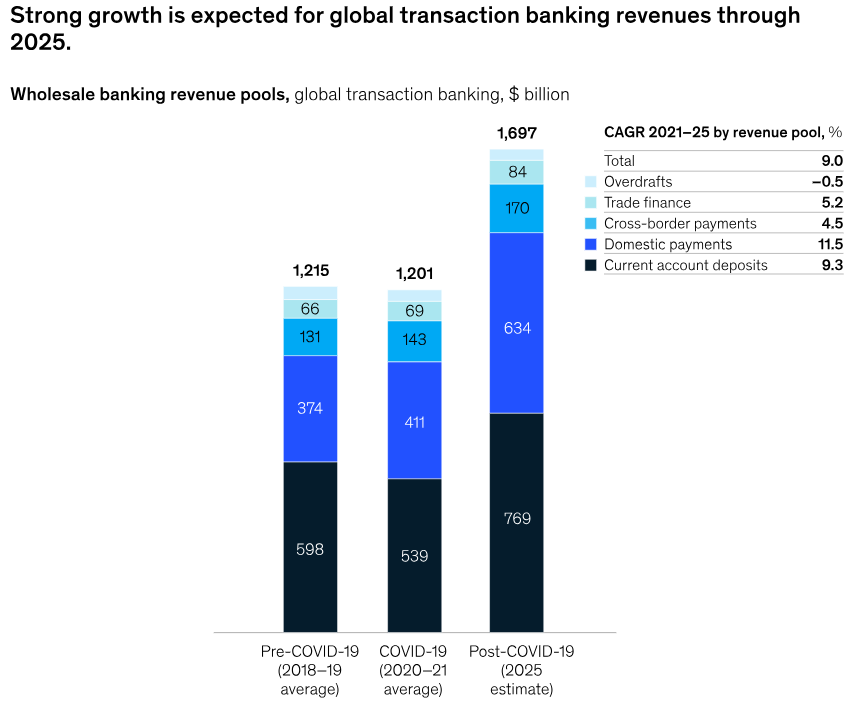 (Source: mckinsey.com)
(Source: mckinsey.com)
- A study found that hiring, training, and onboarding new employees remotely are the biggest recruitment problems for employers during the global health crisis.
- When hiring remotely because of the pandemic, 51.7% of managers said that keeping candidates engaged was the toughest challenge, as stated by Onboarding Statistics.
- Others cited onboarding new hires (49.7%) and evaluating their performance (42.4%) as difficult.
Conclusion
Onboarding a new employee benefits the company, managers, teams, and the new hire. But remember, onboarding isn’t just the HR department’s job. Onboarding involves more than just completing forms and checking details. It’s an ongoing process that can last up to 90 days or even longer. In addition to training, it’s important to set goals with the new employee and have weekly check-ins to ensure they’re getting the help they need. Onboarding is a key opportunity. It gives the new hires their first look at the company, helps them understand their job and performance goals, and shows how their work supports the company’s success.
Sources
FAQ.
To find the onboarding completion rate, do the following:
- Divide the number of users who finished onboarding by the total number of users who started onboarding.
- Multiply the result by 100 to get a percentage.
The engagement rate shows the % of users in a group who actively use your product over a specific period. To get the best results from this metric, divide your users into groups based on when they began onboarding.
The three main elements of onboarding are:
- Orientation: Showing new hires around the company and its culture.
- Integration: Helping new hires become part of the team.
- Communication: Ongoing interactions to improve engagement and productivity.
Oracle HCM Cloud Onboarding involves:
- Making it easier for new hires to get started with the company.
- Automating tasks and paperwork related to onboarding.
- Providing personalised welcome experiences for new employees.
- Allowing new hires to complete forms and learn about the company culture online.

Saisuman is a professional content writer specializing in health, law, and space-related articles. Her experience includes designing featured articles for websites and newsletters, as well as conducting detailed research for medical professionals and researchers. Passionate about languages since childhood, Saisuman can read, write, and speak in five different languages. Her love for languages and reading inspired her to pursue a career in writing. Saisuman holds a Master's in Business Administration with a focus on Human Resources and has worked in a Human Resources firm for a year. She was previously associated with a French international company. In addition to writing, Saisuman enjoys traveling and singing classical songs in her leisure time.











